RandomAfricanAm's Posts
Nairaland Forum / RandomAfricanAm's Profile / RandomAfricanAm's Posts
(1) (2) (3) (4) (5) (6) (7) (8) (9) (10) (11) (12) (13) (14) (15) (16) (of 18 pages)
Not to take this thread of track, but after posting those band videos for comparison I got into watching more band videos. (I found this one to good not to share, I love my peoples  ) ) Prairie View A&M University: part of the Texas A&M University System PVU Marching Storm - Homecoming Tunnel (2013) https://www.youtube.com/watch?v=4BN_GynQIik I'd love to see one of these shows with west African masquerade costumes on instead of the European marching band uniforms. That would be bad ass!!!   I can definitely see a situation where instead of the regular drum major outfit...   He'd have on like this(see one in the middle )...  Example: 1:10 - 3:00 https://www.youtube.com/watch?v=t-va-XaU18o |
I'm good I was just replying to PS: I've unhidden your first post on that thread. Try not to modify it again so as to prevent the anti-spam bot from automatically hiding it again. |
Workshop discussing the book in depth. 1 of 19 https://www.youtube.com/watch?v=2X_NwaHQsOA 2 of 19 https://www.youtube.com/watch?v=WQGXSr4R5Mw 3 of 19 https://www.youtube.com/watch?v=6k9-qSdjaqk 4 of 19 https://www.youtube.com/watch?v=M8qAE4WM9nU The rest are in this playlist http://www.youtube.com/playlist?list=PL4B5C71D66F674B0F |
 WOW, I'm still running this work through my head! It's an anthropological break down of the entire core of the Western institution.*Note: I didn't say people* because the institution is what reproduces and perpetuates the western mind set which in turn automates the body/actions of the people. It's similar to how Europeans sit in African villages and try and tell us why the people do what they do yet in this case the mirror is turned around. Though to be fair I think it's one of those things that derives much of it's value from being versed in the subject. The subject in this case being intellectual history with a focus on philosophy, religion, science, academia, etc *note that I emphasized cultural thought forms and not any specific people* that distinction is important or you'll miss the importance IMO. Here is a great review of the work! Let me start off by saying that I am Turkish, and this is one of my favorite books of all time, and I have lent it and gifted it to many people I care about! Though this is a book by a Black Studies scholar of Afrikan descent, written for a Black audience, you don't have to be Afrikan to get something out of it. The tensions and polarities she describes so eloquently (reason v. emotion, objectivity v. subjectivity, holism v. reductionism, linear v. cyclical thinking, science v. spirituality, etc.) are at the root of significant social trends in every culture, inform behavior between individuals, and influence the direction and nature of one's own personal growth. I am of Turkish descent, and this book helped me understand my culture (and more importantly MYSELF) better than it did Afrikan culture! It changed my life and influenced me to make many positive changes in the way I viewed myself and the world and related to others and my environment! Interview regarding the book https://www.youtube.com/watch?v=FkkNa7eMyF0 A talk to covering the material in the book. (the video time is wrong the talk's not really that long) https://www.youtube.com/watch?v=lPgHHysSzhM |
I couldn't resist  [img]http://blackmystory.files./2012/11/564132_385588838156605_877675666_n.jpg?w=523&h=417[/img] 1 Like |
Fulaman198:Hmm... A good outline would be 1.Formation of the Sahale as the Sahara dries out, from the Niger bend, lake chad, to the Nile valley. (Early Habitable places in the Sahale versus the Sahara) 2. Earliest know inhabitants of the Sahale with a focus on lake chad area 3. Basic overview of cities along trade routs between lake chad and Upper Nile valley with a focus on El Fashur and the Darfur region. (basic history of each city) 4. Trade with Kerma via the Sahale (Projections using trade with Egypt via items not native to the Nile valley as a proxy) 5. Fall and Dispersal of the Kerma people (possible routs of dispersal using historical movements across the Sahale under similar situations as a model) 6.Nubia trade via the Sahale (Projections using trade with Egypt via items not native to the Nile valley as a proxy) 6. Sao and Garamantes 7.Christian nubia trade via the Sahale Note: I actually have a pdf detailing finds of Christian Nubia all the way in lake chad. 7. Basic history of Fulani in relation to Sahara and introduction to Sahale 8. Basic history of Tuareg in relation to Sahara and introduction to Sahale 9. Basic history of Kanem - Bornou complex and it's impact on the surrounding people especially cities along trade routes 10. Further drying of Sahara to current point and impact on inhabitents 11. Basic pictorial/blurb on the current different inhabitants of Sahale region in general (with a note on the current ecological state of the region) 12. A Focus on the current Inhabitants of Southern Chad, Eastern Niger, Northeast Nigeria, lake Chad, Darfur, and Northern Cameroon. . . . . . That's what imedeatly comes to mind though I feel I'm missing something. There is actually a Sahale history group, I have one of there releases in PDF format but they don't deal in chronology they deal n isolated topics which is what I'm trying to move away from. I like taking one component/topic and walking it in chronological order through history. I feel I get more incite into way certain things happen at certain times. Forcetotal = Force1 + Force2 + Force3 +....+ Forcen On a side note: (a summery translation would be cool) https://www.youtube.com/watch?v=FHWGcUxNYC8 https://www.youtube.com/watch?v=9dVTTFYbY98 https://www.youtube.com/watch?v=n3cOZK28CuQ https://www.youtube.com/watch?v=iakEJ_ALBgU https://www.youtube.com/watch?v=h1z_nLaAHo4 |
@1:15 he speaks of women with "special powers" I assume divination. What is the function of this person in society? https://www.youtube.com/watch?v=86bWtyiSX6U Thanks |
Spam bot got me again!? That thing must hate me  Thanks man |
Igbos and AAs share a lot of resemblance. Below are pictures from the Umu Igbo 9th Convention held at Dallas Texas recently. From the images, you'll find it difficult to differentiate. Agreed, now contrast that with these students from "Alabama State University" an HBCU(Historically black college/University) from my state of Alabama which is two states over from Texas were those pictures above were taken(My aunt is actually a nurse out in Dallas Texas). Both states being located in the U.S. black belt region(Were most African Americans live) https://www.youtube.com/watch?v=LYxD0XfM6rY https://www.youtube.com/watch?v=q_TScx-XuxM   . . . . . . . . . Kinda off topic but since I'm talking about Alabama and the U.S. Black Belt Region here is a funny story from there. **Warning strong language** https://www.youtube.com/watch?v=PToqVW4n86U 1 Like |
I was born and raised deep in the U.S. Black Belt Region  In Alabama  I came across the "The Legend Of Kedh Gurrai" and thought it would be of interest. It's also a region that's not discussed enough and respected as the main African east-west corridor that's had important implications throughout history in terms of migration and trade. Someone really needs to do a comprehensive history/historiography of the Sahale. I'd love to read it! |
I agree with being concise...
I'm also cautious not to betray the topic or "talk down" to my intended audience. I've never been a big fan of the "A.D.D generation"(everyone has a short attention span) position. In general I believe in the potential of people(whether they meet it or not). In this case the potential I'm referring to is the taking in, sharing, and processing of information concerning the migration of Africans out of the Sahara into the Arabian peninsula; using the extent to which Africans where pushed in other directions of the Sahara as context for how far they could have been pushed east. My method to help the audience meet that potential is not by truncating the info(for a perceived attention deficit) **I don't think it's an attention issue at all people simply know what they feel like/have time for consuming and need a method of determining if they want to invest time**. I help that potential along by structuring the info for layered consumption. 1.The first thing I did was split the question at hand from the context(If interested in the question keep reading if not go with love) 2.Second the important parts of the context is embolden and coupled with pictures so that the interested audience can get a quick executive level summery of the topic. 3.Third if seriously interested they can read it in context by reading the unembolden parts. 4.I go back from time to time to touch up my articles to make them clearer**that's probably what's erking the spam-bot...hmm** I suggest you go back **don't read it** but actually look at it's structure instead. It's made for very quick consumption and lets you know if you even want to consume in the first 4 lines by separating the question for the context. https://www.nairaland.com/1530367/when-arabian-peninsula-northeast-africa |
This video says of the current Lebanese population "only 27 percent of the population carries the Phoenician gene the rest are a genetic cocktail" I.E most people in modern Lebanon are not genetically representative of the ancient Phoenicians. https://www.youtube.com/watch?v=TCCwqSIpERA Now in this video Spencer wells of the Human Genographic project states that "we are not seeing a significant genetic influence on the coastal populations of the lavent from elsewere they look very similar to the groups we see inland in Syria and jordan" https://www.youtube.com/watch?v=-ZjF5IfuML0 "We're not seeing a significant genetic influence from elsewhere on the coastal population in what was the Levant region," says Wells. "The people are very similar to the groups we see inland in Syria and Jordan, for example, suggesting that there wasn't a huge influx of Sea Peoples or others from outside the area. A cultural shift occurred but not a genetic one. Today's Lebanese, the Phoenicians, and the Canaanites before them are all the same people." - http://ngm.nationalgeographic.com/ngm/0410/feature2/online_extra.html but spencer wells is contradicted by the data from his own research that states "only 27 percent of the population carries the Phoenician gene the rest are a genetic cocktail" Now lets dig into history for some context...
Spencer wells blind spot is that he only looks at one possibility The sea peoples That result extinguishes Wells' theory that the migrating Sea Peoples interbred with the Canaanites to create the Phoenician culture.- http://ngm.nationalgeographic.com/features/world/asia/lebanon/phoenicians-text/5 He also states that only %10-%20 "or even less" of Carthage was from the "middle east" and that the rest were "aboriginal North Africans". But never explores the idea that some of the Phoenicians themselves might have been of the same "genetic stock" as those north Africans in the first place. Egyptians had numerous sites in "cannon land"  ....and the nile valley is also were the berber linguistic group came from. This sounds to me like at some point the Arabian peninsula was overran by "foreigners". Now we know of the Ottoman Turks and their Eastern European, caucus, and Mediterranean slaves and transplants that were moved throughout there empire. [img]http://2.bp..com/_pR-VDlMPyvQ/TJJ4hGeZXyI/AAAAAAAAC1E/_UbxHCeudbI/s1600/osmanli%5B1%5D.gif[/img] (People tend to forget that while the Ottomans took Islam They oppressed Arabs the same as everyone else in there empire. So much so that the Arabs teamed up with the British in WW1 to kick out the ottomans) But what about before that period, around their contemporary times...(See next post) |
Are you referring to... the post that I asked to be unhidden or the post in this thread above with the fingers crossed image? |
High atop a dusty plateau on the Arabian Peninsula, archaeologist Jeffrey Rose picked up a rock, saw something surprising, and started asking questions that could change history. His unusual discoveries in southern Oman help shape new theories about when early humans may have exited Africa, who those pioneers were, and what route they took on the first stage of their journey to every corner of the Earth. In the late 1990s geneticists identified mitochondrial DNA signatures suggesting that the first humans to leave Africa may have traveled through Ethiopia to Yemen and Oman. Scientists theorized they were beachcombers who followed the coastline. Rose arrived in the area, eager to test the theory that Arabia was the gateway out of Africa by searching for archaeological evidence. "We surveyed for years," he recalls. "Stone Age artifacts littered the landscape; virtually any place I stopped the car, I found a Paleolithic site. But none of it showed a connection to Africa; and along the coast we found no evidence of humans at all." [b]He and his international team of scientists returned to Oman in 2010, and on the final day of their surveying season, at the last site on their list, "we hit the jackpot." The find was a very specific stone tool technology used by the "Nubian Complex," nomadic hunters from Africa's Nile Valley. Nubian technology is a unique method of making spear points that was previously only known from North Africa. Rose's team ultimately discovered over a hundred workshop sites where these artifacts were manufactured en masse. "It was scientific euphoria," he describes. The Nubian origin and inland location of the discovery were equally unexpected. "We had never considered the link to Africa would come from the Nile Valley, and that their route would be through the middle of the Arabian Peninsula rather than along the coast," Rose notes. "But that's what the scientific process is all about. If you haven't proven yourself wrong, you haven't made any progress. In hindsight, the Nubian connection makes perfect sense. The Nile Valley and Oman's Dhofar region are both limestone plateaus, heavily affected by perennial rivers. It's logical that people moved from an environment they knew to another one that mirrored it.[/b] At the time when I'm suggesting they expanded out of Africa, southern Arabia was fertile grassland. The Indian Ocean monsoon system activated rivers, and as sand dunes trapped water, it became a land of a thousand lakes. It was a paradise for early humans, whose livelihood depended upon hunting on the open savanna." Accurately dating Rose's Nubian discovery was made possible by optically stimulated luminescence (OSL) technology, which can determine the last time a single buried grain of sand was exposed to light by measuring the amount of energy trapped inside of it. The technique revealed the tools to be 106,000 years old, exactly the same time the Nubian Complex flourished in Africa. This also means Rose's theory places the first exit from Africa much earlier than previously believed. "Geneticists have shown that the modern human family tree began to branch out 60,000 years ago. I'm not questioning when it happened, but where. I suggest the great modern human expansion to the rest of the world was launched from Arabia rather than Africa." Rose's passion for the past extends beyond fieldwork to how science can be shared with the public. "A few years ago, I was going through an incredibly dramatic wadi (valley) in Oman, hours off the beaten track, and I thought, wouldn't it be great if we could share this place with other people, I bet they'd love to see this." He began shooting short videos every few days and chronicling his work via Twitter updates and website posts. "You can't put into words how unique the landscape here is. Arabia feels like this romantic lost world filled with mysterious ruins; it's a living museum of artifacts. Everyone on Earth had ancestors who passed through this place; why wouldn't you want to show it to people?" "I'm like a kid in a candy store, there's so much to learn; and now we have so many ways to disseminate information—the Internet, blogs, myriad TV channels, documentaries—it's all making science more interesting, digestible, and relevant to the public," he says. "There's no reason for archaeology and history to be stuffy. How could you not want to know how you got here? It's been said that there's more diversity within a group of 55 chimpanzees than in the entire human population. I think if we help people conceptualize how tiny the genetic distance is between them, it might even help bridge some of the tensions in our world today." Trying to explain what keeps him based in a desert truck stop, digging through sand, and lugging 100-pound loads of rocks in 100-degree heat, Rose says, "It's like an itch you absolutely have to scratch. An answer you have to find. Who lived here? What were they doing? Are these the people who went on to colonize the entire world? Now that we know it was the Nubians who spread from Africa, I want to know why them in particular? What was it about their technology and culture that enabled them to expand so successfully? And what happened next? That's one of the defining characteristics of our species—we've always looked to the beginning and wanted to understand how we got here. That's what it means to be human." http://www.nationalgeographic.com/explorers/bios/jeffrey-rose/ **full study** The Nubian Complex of Dhofar, Oman: An African Middle Stone Age Industry in Southern Arabia http://www.plosone.org/article/info:doi/10.1371/journal.pone.0028239 [img]http://2.bp..com/-JlXZLt_3JOw/Tta14KZtGmI/AAAAAAAAEWE/6n66C1OgEZ8/s1600/journal.pone.0028239.g006.png[/img] [img]http://2.bp..com/-B8oChlD6p-A/TtavCMCBtVI/AAAAAAAAEV4/eNU2HOFJNck/s1600/journal.pone.0028239.g001.png[/img] ^ Note the coastlines during that time of the Pleistocene when these cultures were extant. The Red Sea was narrower and Africa and Arabia were much closer to each other. The Bab-el-Mandeb Straits was longer and thinner separating Eritrea and Yemen by only a few miles. **Also note that the Ethiopia/Eritrea area was in cultural continuity with the goings on in the Nile valley/Sahara. looks like by way of the blue nile or the coast splitting at the straits crossing** which fall into place when looking at trade route paths over time**they had to be found at some point**  [img]http://upload.wikimedia.org/wikipedia/commons/b/b7/Niger_saharan_medieval_trade_routes.PNG[/img] And how civilizations come up along those trade routes...  ...and absorbed the other along those same trade routes as well. 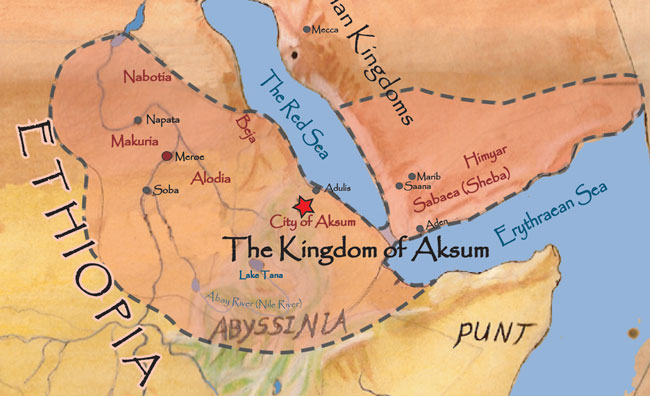 Incredible Human Journey, Episode 1, Arabia Sequence (Eden) https://www.youtube.com/watch?v=YIJeFL6uOqU 1 Like |
Big'ol hugs and a golden nugget for Fulaman! **I put a lot of work into that post** . "Not to sound mean, but..."Hey, no animosity felt here. I can't know unless I'm informed and now I know. **I just didn't know if you would have to jump through a hoop or two to fix it.(hence the justification)** Thanks, I've been made a believer in the nairaland system/culture board! |
OK this is a "make or break" favor  I spent a solid hour building a great post with peer reviewed material and links detailing the movement of people out of the Sahara desert and their subsequent populating of the African continent. In it I questioned the possibility of being pushed not only to the Nile valley but also the Levant along with other place on the Arabian peninsula. Before posting it I copied it incase It was to long or something weird happened. It posted fine so I went ahead and started to add an addition to the thread detailing the Nubian tool complex normally found around the nile valley but currently found to stretch down into the southern Arabian peninsula around Oman dated to 100k BC which is prior to the 60k BC "Out of Africa migration". Obviously this shows that the sea was no real barrier and that the same culture if not people inhabited the Nile valley and parts of Arabia prior to being pushed out of the Sahara. When I went to add that new post I was auto-banned and got the message... "This topic has been removed or hidden" This is the location it was at (posted around 2:00am EST 11/25/2013) https://www.nairaland.com/1530367/how-accurate-say-map-anthropologist If you can't reopen it or even retrieve some kind of raw data dump that I can use to repost it I will be in a position were I will be far less likely to really put in work to make good post out of fear of a similar thing happening (I can't find those references/quotes again)  Please work yo magic !?!? [img]http://image.forumfree.it/7/8/0/6/0/6/5/1373750494.png[/img] |
Question: (For the anthropologist among us) 1. Do you think the desiccation of the Sahara could have pushed Africans farther then the Nile valley into the Arabian peninsula? 2. How accurate would you say this map is? 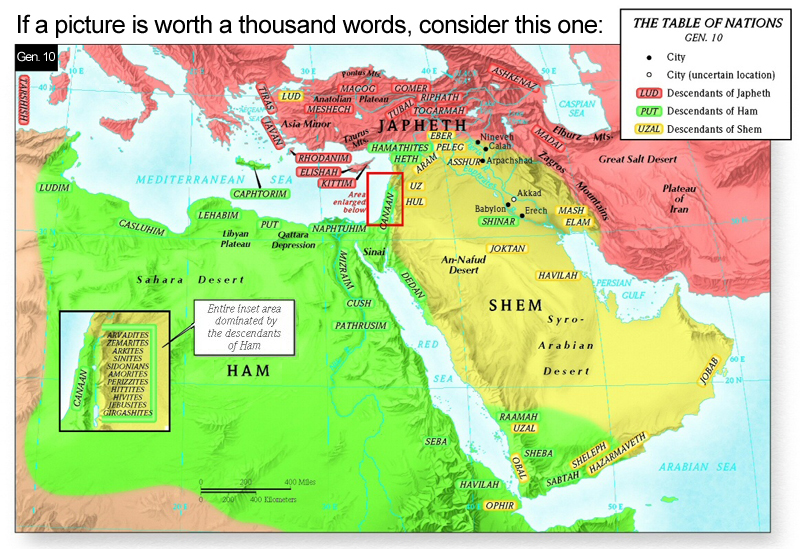  **Yes they are contradictory** Context: I've been moving away from the two terms Black and African. Not that there is anything necessarily wrong with them it's just that they tend to fall apart under close scrutiny. To be more precise, when used as delineators for sorting & grouping people the results tends to not be representative of what the terms Black and African Denote. The sorted group tends to fall under the connotation of those words which differ given different people, cultures, and politics. As a result and for the time being... When I say "Black people" I'm referring to a subset(undecided) of humanity that is tropically adapted(which is my delineator) independent of any genetic make up or place of birth/residence. When I say "African people" I'm referring to a subset of humanity that dwelled in and migrated out of the current day Sahara-Sahale region during it's green phase and subsequent Desertification. This includes the people they absorbed in the process of spreading across the continent & world. This is independent of birth place, politics, religion, culture, phenotype, or nationality.(because they are not the delineator) This is generally typified by the genetic presence of paternal PN2 and maternal L1, L2, L3 **These are not hard fast definitions it's simply were I'm at right now** As always when thinking about cultural groups I start by mentally moving through the movements of people until I get to the period under question then I stop and review what I have before me. The difference is that now I'm going to start doing it in the open instead of mentally.**I need to make a gif for this purpose** Prior to ejection from the Sahara: Africans have been in the sahale-Saharan area since at least around the aqualithic /green Saharan period. 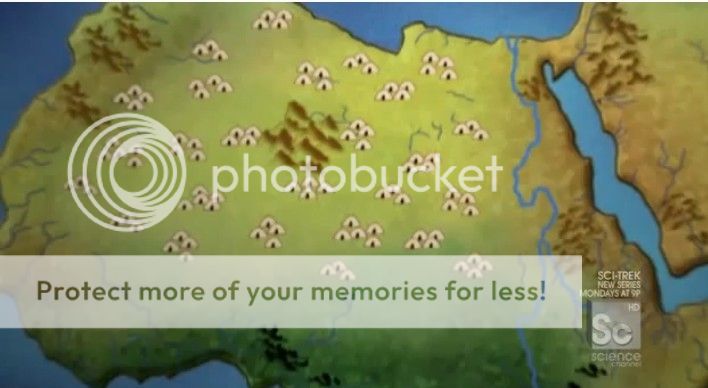 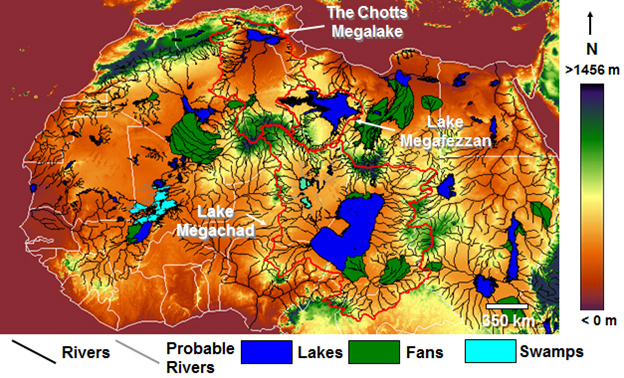 The occupation of the Sahara was one that shared certain material culture commonalities throughout such as barbed harpoons for fishing and wavy lined pottery for storage. [img]http://openi.nlm.nih.gov/imgs/rescaled512/2515196_pone.0002995.g007.png[/img] [img]http://mathildasanthropologyblog.files./2008/08/ten-pot.jpg[/img] 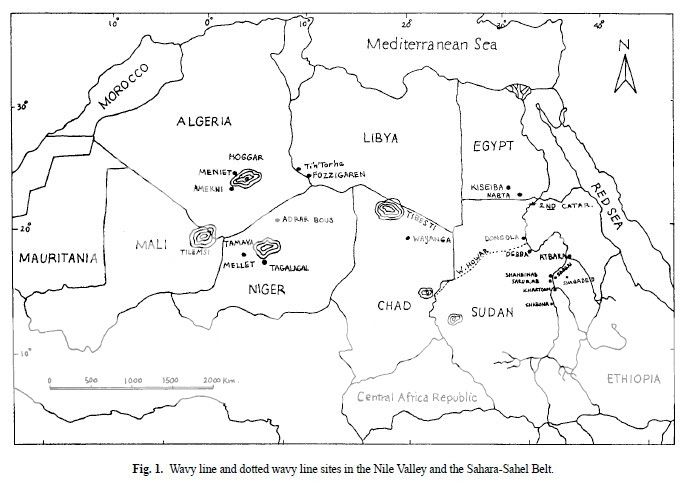 Ejection from the Sahara: Southward As the Sahara began to dry out the people began to be pushed out of and mashed between, the desert and forest belt in what is now called the Sahale, gathering primarily around lake chad creating and extending across the ancient sahale to Nile trade routs.  Trailing the river routs down into Cameroon and Nigeria were they would set the staging grounds for the later bantu migration to occur as the area becomes overpopulated from reproduction and further dessication in the north pushes more people south.  Ejection from the Sahara: Westward To the west they were pushed to the Niger bend and Southern Mauritania resulting in early population centers around Tichitt-Walata. 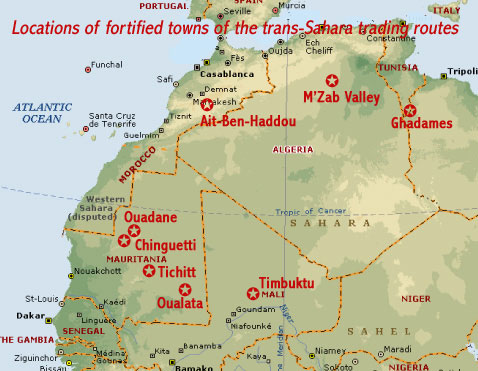  [img]http://img1.advisor.travel/f550x450px-9010136964c1ccca6c8cc6581580774.jpg[/img]    Tichitt-Walata and the Middle Niger: evidence for cultural contact in the second millennium BC **Further reading** http://www.yumpu.com/en/document/view/10874841/tichitt-walata-and-the-middle-niger-panafrican-association-of- Ejection from the Sahara: Eastward To the east they gathered around the Nile valley  "The evidence also points to linkages to other northeast African peoples, not coincidentally approximating the modern range of languages closely related to Egyptian in the Afro-Asiatic group (formerly called Hamito-Semetic). These linguistic similarities place ancient Egyptian in a close relationship with languages spoken today as far west as Chad, and as far south as Somalia. Archaeological evidence also strongly supports an African origin. A widespread northeastern African cultural assemblage, including distinctive multiple barbed harpoons and pottery decorated with dotted wavy line patterns, appears during the early Neolithic (also known as the Aqualithic, a reference to the mild climate of the Sahara at this time). Saharan and Sudanese rock art from this time resembles early Egyptian iconography. Strong connections between Nubian (Sudanese) and Egyptian material culture continue in later Neolithic Badarian culture of Upper Egypt. Similarities include black-topped wares, vessels with characteristic ripple-burnished surfaces, a special tulip-shaped vessel with incised and white-filled decoration, palettes, and harpoons... Other ancient Egyptian practices show strong similarities to modern African cultures including divine kingship, the use of headrests, body art, circumcision, and male coming-of-age rituals, all suggesting an African substratum or foundation for Egyptian civilization.. Source: Donald Redford (2001) The Oxford encyclopedia of ancient Egypt, Volume 3. Oxford University Press. p. 28 Resulting in the moving of people from the south founding the Nile valley civilizations of Kerma/kush and kemet(ancient egypt) [img]http://1.bp..com/-nzzzWlQL3OQ/To1qWz78fSI/AAAAAAAAACk/BZZ7-lXdnYw/s1600/kerma.gif[/img]    Early settlement Human populations settled in the Kerma Basin at a very early date, as evidenced by several Mesolithic and Neolithic sites. The earliest traces of a human presence in the region date back tens of thousands of years. From 7500 BC onward the archaeological remains become more significant: semi-buried dwellings, various objects and tools, and graves.[5] What’s clear is that Kerma’s civilisation emerged out of an ancient pastoral culture that had flourished in that part of Sudan since at least 7000 B.C. when the first settlements were established. Near Kerma, archaeologists have discovered one of the two oldest cemeteries ever found in Africa – dating back to 7500 B.C. – and the oldest evidence of cattle domestication ever found in Sudan or, indeed, in the Egyptian Nile Valley. Around 3000 B.C., a town began to develop near the Neolithic dwellings. Pre-Kerma (c. 3500-2500BC) No C-Group Phase Early Kerma (c. 2500-2050BC) C-Group Phase Ia-Ib Middle Kerma (c. 2050-1750BC) C-Group Phase Ib-IIa Classic Kerma (c. 1750-1580BC) C-Group Phase IIb-III Final Kerma (c. 1580-1500BC) C-Group Phase IIb-III Late Kerma – ‘New Kingdom’ (c.1500-1100?BC) ‘New Kingdom’ The Eco-Political Structure of Kerma Until recently, the Kerma civilisation was known only from the townsite and cemeteries of its metropolitan centre and smaller sites to the north, towards Egypt. However, recent survey and excavation work has identified many new sites south of Kerma, many located on channels of the Nile, now dry, which lay to the east of the modern course of the river. This pattern of settlement indicates a substantial population and for the first time provides us with some sort of context in which we can place Kerma itself. Survey work in advance of the Merowe Dam at the Fourth Cataract has confirmed the presence of Kerma sites at least as far upriver as the Abu Hamed/Mograt Island area.[1] Kerma was evidently a sizable political entity - Egyptian records speak of its rich and populous agricultural regions. Unlike Egypt, Kerma seems to have been highly centralized. It controlled the 1st to 4th Cataracts, which meant its domain was as extensive as ancient Egypt.[2] Numerous village communities scattered alongside fields of crops made up the bulk of the realm, but there also seems to have been districts wherein pastoralism (goat, sheep and cattle) and gold processing were important industries.[3] Certain Kerma towns served to centralize agricultural products and direct trade. Analysis of the skulls of thousands of cattle interred in royal Kerma tombs suggest that stock were sometimes brought vast distances, from far districts, presumably as a type of tribute from rural communities on the death of Kerma's monarchs. This parallels the importance of cattle as 'royal property' in other parts of Africa at later times. Only the centres of Kerma and Sai seem to have had contained sizable urban populations. Possibly further excavations will reveal other regional centres. At Kerma and Sai, there is much evidence of wealthy elites, and a class of dignitaries who monitored trade in merchandise arriving from far-off lands, and who supervised shipments dispatched from administrative buildings. Evidently Kerma played an important 'middle man' role in the trade of luxury items from the African interior to Egypt [4]   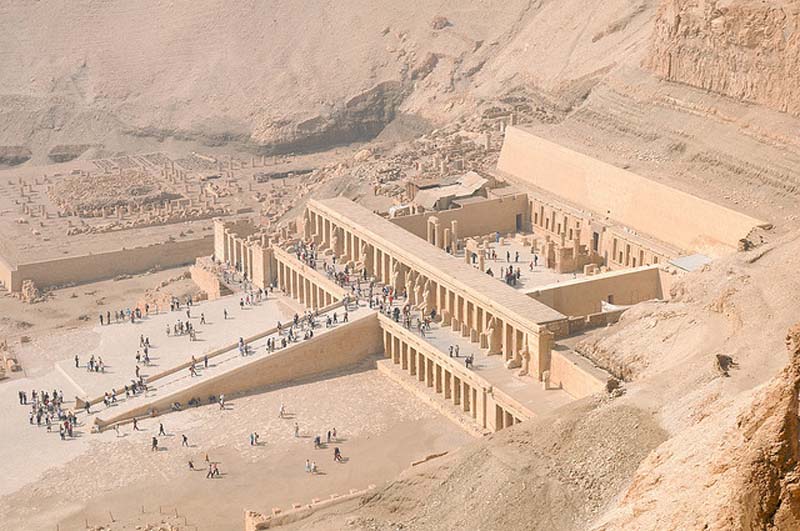 Ejection from the Sahara: Northward Subsequently moving into north Africa at a much later date 1000 BC - 100 AD ABSTRACT The Berber languages are relatively well-studied, and it is possible to explore their geographical extent today and in the past, and also reconstruct basic and culturalvocabulary which can be attributed to speakers of proto-Berber. However, there is a major problem reconciling this with textual and archaeological evidence. The proto-Berber we can reconstruct seems to be far to recent to match what we know from other evidence; indeed it seems to reach back to period as late as 200 AD. Textual evidence (and Canarian inscriptions) point to a period prior to 400 BC, while the most credible archaeological correlate would be the spread of pastoralism across the Sahara, pointing to the period 5-4000 BP. The paper explores this disjunction and suggests the underlying reason for it is massive language levelling in the period after 0 AD. In other words, the original speakers of Berber did indeed spread out westwards from the Nile Valley, 5-4000 years ago, but the diversity which evolved in this period was eliminated by a sociolinguistic processes which levelled divergent speech forms. Historical linguists have been wary of invoking such process until recently, but evidence is mounting for their importance in many and varied cultures, including China, Borneo and Madagascar. Hypotheses are evaluated to explain the Berber situation and it is suggested that a combination of the introduction of the camel and the establishment of the Roman limes were the key factors in creating this linguistic bottleneck. -Recent work by Roger Blench. http://www.rogerblench.info/Archaeology/Africa/Berber%20prehistory%202012.pdf ************ Ejection from the Sahara: Into Arabian peninsula But again how far would you say the Saharan population was pushed given the info at your disposal?   “From a genetic point of view, several recent genetic studies have shown that subSaharan genetic lineages (affiliated with the Y-chromosome PN2 clade; Underhill et al. 2001) have spread through Egypt into the Near East, the Mediterranean area, and, for some lineages, as far north as Turkey (E3b-M35 Y lineage; Cinniogclu et al. 2004; Luis et al. 2004), probably during several dispersal episodes since the Mesolithic (Cinniogelu et al. 2004; King et al. 2008; Lucotte and Mercier 2003; Luis et al. 2004; Quintana-Murci et al. 1999; Semino et al. 2004; Underhill et al. 2001). This finding is in agreement with morphological data that suggest that populations with sub-Saharan morphological elements were present in northeastern Africa, from the Paleolithic to at least the early Holocene, and diffused northward to the Levant and Anatolia beginning in the Mesolithic. Indeed, the rare and incomplete Paleolithic to early Neolithic skeletal specimens found in Egypt - such as the 33,000-year-old Nazlet Khater specimen (Pinhasi and Semai 2000), the Wadi Kubbaniya skeleton from the late Paleolithic site in the upper Nile valley (Wendorf et al. 1986), the Qarunian (Faiyum) early Neolithic crania (Henneberg et al. 1989; Midant-Reynes 2000), and the Nabta specimen from the Neolithic Nabta Playa site in the western desert of Egypt (Henneberg et al. 1980) - show, with regard to the great African biological diversity, similarities with some of the sub-Saharan middle Paleolithic and modern sub-Saharan specimens. This affinity pattern between ancient Egyptians and sub-Saharans has also been noticed by several other investigators..” --Ricaut and Walekens (2008) ‘Cranial Discrete traits) https://www.youtube.com/watch?v=YlSAEuIIYVY 1 Like |
KidStranglehold: RandomAfricanAm: |
PAGAN 9JA: Ahhh, umm ......Mmmm (something smells fishy here) sniff sniff.... Hmm, I smell politics at play . . . . . . . . . . . . . . I'll sit back and watch  |
Since we are talking about biblical issues I'll toss one at you guys enjoy... https://www.youtube.com/watch?v=YlSAEuIIYVY @KidStranglehold: First off: I have no real dog in this fight. Also I'm not in any field of anthropology. That said, speaking from my background I have to say that I get really annoyed with the argument in bold above. (Not because it's not true, because it is) But from the stand point of sorting and clustering data(of any kind) it's besides the point or to make it clearer it's arguing the wrong point. It also shows how annoyingly long a shadow people like Carlton coons and friends cast. If I sort/cluster people using gold teeth as a delineator...     . . . [img]http://www.troll.me/images/the-most-interesting-man-in-the-world/i-dont-always-get-paid-but-when-i-do-its-in-gold-teeth.jpg[/img] Would it be correct to say "yes they all have gold teeth but they don't all have the same mother & father"? Absolutely that would be correct. But from a dry "matter a fact" stance it's beside the point. There is no such thing as a correct cluster outside of the question of "does it satisfy the delineator(s) used in the sorting process". If it meets those requirements the next line of questions would be "what will this cluster be used for?"(I already see what it is) The thing is whenever I see the issue of "blacks in Asia" that last part is always skipped in the automatic assumption of the return/propagation of biological race based theory. That's like telling these people...   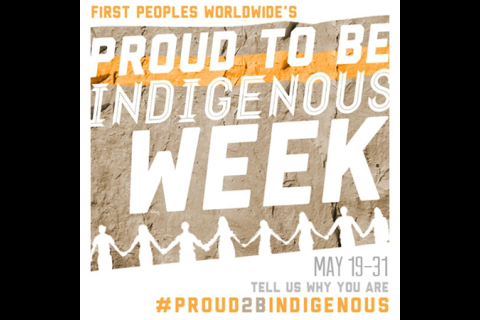 "You people aren't genetically related so you can not advocate as a group" As far as I'm concerned as long as they don't advocate the busted ideology of biological races and assorted nonsense terms like Caucasoid, negroid, mongoloid etc. they can sort and galvanize around what ever delineator that successfully brings them together for a common cause. It's the knee jerk reaction to the "shadow of coons"(which is basically what it is) that annoys me most. |
The basis of Igbo Spirituality is the concept of “Chi.” Similar to the “Ori” of the Yoruba, and the “Ka” of Ancient Egyptians, Chi was the fundamental force of creation.. . . . [size=18pt]A Naturalistic Interpretation of the Yoruba Concepts of Ori [/size] [size=16pt] Adebola Babatunde Ekanola [/size] Department of Philosophy University of Ibadan, Nigeria Introduction Ori is a central concept in Yoruba-language conception of human personality.1 The Yoruba are said to believe that the personality of each individual is predetermined Ori. In this paper, I aim to show that the available accounts of Ori constitute an inadequate explanation of this determinism——-what is popularly translated as destiny—in Yoruba thought. In place of the spiritualistic predetermination of personality implied in the idea of destiny, I wish to offer a naturalistic, humanistic account of Ori. The Myth of Creation One of the available versions of the Yoruba account of the creation of the human person holds that the human body (ara) was molded by Orisanla (one of the deities in Yoruba traditional religious system) out of sand. It is thereafter that the lifeless body is infused with emi (life or breath of life) by Olodumare (supreme deity). The body at this stage becomes activated with life and then goes to Ajala (deity responsible for making Ori) to select an Ori.2 The act of selecting Ori in Ajala’s house has three important aspects:3 First, its supposed to be one of free choice. You are said to be free to choose any of the Ori available in Ajala’s storehouse. Second, the Ori selected determines, finally and irreversibly, the life course and personality of its possessor on earth. Third, each individual is unaware of the content or quality of the chosen Ori, that is, the person making the choice does not know if the destiny embedded in an Ori is good or bad. Other terms used to symbolize Ori include Akunleyan (that which is chosen kneeling), Ipin-Ori (allotment), Aycmmo (that which is chosen or affixed to oneself), and Akunlegba (what is received kneeling). Apart from the above account of the determination of destiny through a choice of Ori in Ajala’s house, there are other versions of the Yoruba belief on the determination of destiny. One such version has it that it is Olodumare who confers destiny on each human person, which is later doubly sealed by Onibode (the keeper of the gate between heaven and earth.)“ However all the available versions agree that destiny is determined by the Ori, either chosen or conferred upon a person. They also agree that by the time people arrive in the world, through birth, they are totally ignorant of the type of destiny awaiting them. . . . . Up next: A Critical Analysis of the Myth |
Sorry the bot banned me twice while replying to different threads. I'm coming back to this topic. I have some good info to add that I never got around to because I was trying to find an online converter for the pdf file I was viewing.(The text was protected from copy&paste) |
Hello, can you ask the moderator of the culture board to unban me (I got hit by the spam bot) https://www.nairaland.com/231979/complaints-notice-thread-serious . Also to unhide my post in https://www.nairaland.com/1241171/african-elites-india Thank you **BTW I asked here because I don't use multiple accounts** |
History of Blacks in India (Siddi) The Siddi population is currently estimated to be 20,000–55,000, The first Siddis are thought to have arrived in India in 628 AD at the Bharuch port. Several others followed with the first Arab Islamic invasions of the subcontinent in 712 AD.The latter group are believed to have been soldiers with Muhammad bin Qasim's Arab army, and were called Zanjis. Most Siddis, however, are believed to be the descendants of slaves, sailors, servants and merchants from East Africa who arrived and became resident in the subcontinent during the 1200-1900 AD period.A large influx of Siddis to the region occurred in the 17th century when Portuguese slave traders sold a number of them to local princes. In Western India (the modern Indian states of Gujarat and Maharashtra), the Siddi gained a reputation for physical strength and loyalty, and were sought out as mercenaries by local rulers, and as domestic servants and farm labor.[citation needed] Some Siddis escaped slavery to establish communities in forested areas, and some even established small Siddi principalities on Janjira Island and at Jaffrabad as early as the twelfth century. A former alternative name of Janjira was Habshan (i.e., land of the Habshis). In the Delhi Sultanate period prior to the rise of the Mughals in India, Jamal-ud-Din Yaqut was a prominent Siddi slave-turned-nobleman who was a close confidant of Razia Sultana (1205–1240 CE). Although this is disputed, he may also have been her lover. As a power centre, Siddis were sometimes allied with the Mughal Empire in its power-struggle with the Maratha Confederacy. However, Malik Ambar, a prominent Siddi figure in Indian history at large, is sometimes regarded as the "military guru of the Marathas", and was deeply allied with them.[He established the town of Khirki which later became the modern city of Aurangabad, and helped establish the Marathas as a major force in the Deccan. Later, the Marathas adapted Siddi guerrilla warfare tactics to grow their power and ultimately demolish the Mughal empire. Some accounts describe the Mughal emperor Jahangir as obsessed by Ambar due to the Mughal empire's consistent failures in crushing him and his Maratha cavalry, describing him derogatorily as "the black faced" and "the ill-starred" in the royal chronicles and even having a painting commissioned that showed Jahangir killing Ambar, a fantasy which was never realised in reality. Most Siddis are descended from Bantu peoples from Southeast Africa that were brought by the Portuguese.While most of these migrants became Muslim and a small minority became Christian, very few became Hindu since they could not find themselves a position in the traditional Hindu caste hierarchy. On the way to Deva-dungar is the quaint village of Sirvan, inhabited entirely by Siddis, a tribe of African people. They were brought 300 years ago from Africa, by the Portuguese for the Nawab of Junagadh. Today, they follow very few of their original customs, with a few exceptions like the traditional Dhamal dance. Genetics Y DNA A Y-chromosome study by Shah et al. (2011) tested Siddi individuals in India for paternal lineages. The authors observed the E1b1a haplogroup, which is frequent amongst Bantu peoples, in about 42% and 34% of Siddis from Karnataka and Gujarat, respectively. Around 14% of Siddis from Karnataka and 35% of Siddis from Gujarat also belonged to the Sub-Saharan B haplogroup. The remaining 30% of Siddi had Indian or Near Eastern-associated clades, including haplogroups H, L, J and P. Thangaraj (2009) observed similar, mainly Bantu-linked paternal affinities amongst the Siddi.[40] mtDNA According to an mtDNA study by Shah et al. (2011), the maternal ancestry of the Siddi consists of a mixture of Sub-Saharan and Indian haplogroups, reflecting substantial female gene flow from neighboring Indian populations. About 53% of the Siddis from Gujarat and 24% of the Siddis from Karnataka belonged to various Sub-Saharan macro-haplogroup L sub-clades. The latter mainly consisted of L0 and L2a sublineages associated with Bantu women. The remainder possessed Indian-specific subclades of the Eurasian haplogroups M and N, which points to recent admixture with autochthonous Indian groups. [edit]Autosomal DNA Narang et al. (2011) examined the autosomal DNA of Siddis in India. According to the researchers, about 58% of the Siddis' ancestry is derived from Bantu peoples. The remainder is associated with local Indo-European-speaking North and Northwest Indian populations, due to recent admixture events. Similarly, Shah et al. (2011) observed that Siddis in Gujarat derive 66.90%-70.50% of their ancestry from Bantu forebears, while the Siddis in Karnataka possess 64.80%-74.40% such Southeast African ancestry. The remaining autosomal DNA components in the studied Siddi were mainly associated with local South Asian populations. According to the authors, gene flow between the Siddis' Bantu ancestors and local Indian populations was also largely unidirectional. They estimate this admixture episode's time of occurrence at within the past 200 years or eight generations. First Muslims in India According to Historians Elliot and Dowson in their book The History of India as told by its own Historians, the first ship bearing Muslim travellers was seen on the Indian coast as early as 630 AD. The first Indian mosque, Cheraman Juma Masjid, is thought to have been built in 629 A.D, periods Delhi Sultanate Mughal Empire Deccan Sultanate Post Mughal Era BLACK RULERSHIP IN INDIA (HABSHI) The Habshi ruled Bengal for about 6 years within the Sultanate of Bengal The Sultanate of Bengal was a Muslim state that existed from the 14th through the 16th centuries. It was eventually absorbed into the Mughal fold. The Sultanate was ruled by a series of dynasties with both local and foreign origins.  Sardar Singh of Jodhpur (1880-1911) (Muslim) [img]http://realhistoryww.com./world_history/ancient/Images_Indus/maharaja.jpg[/img] British East India Company which was formed in London in 1600 during the rule of Queen Elizabeth I and on 1st January 1858 the British Parliament declared. Queen Victoria of England as the new Empress of India. The British then appointed their Residents as the representa tives of the crown in different princely states of India to look after their administration properly. Marwar (also called Jodhpur region) is a region of southwestern Rajasthan state in western India. Jodhpur state was founded in the 13th century by the Rathore clan of Rajputs, who claim descent from the Gahadvala kings of Kannauj. After the sacking of Kannauj by Muhammad of Ghor in 1194, and its capture by the Delhi Sultanate in the early 13th century, the Rathores fled west. Internecine disputes and succession wars disturbed the peace of the early years of the 19th century, until in January 1818 Jodhpur was brought under British control. Jodhpur became a princely state in the Rajputana Agency of British India. Maharaja Takht Singh (1843-‘73), supported the British during the Revolt of 1857. His successor, Maharaja Jaswant Singh II (1873-‘96), was a very enlightened ruler. His brother, Sir Pertab Singh, conducted the administration until his nephew, Sardar Singh, came of age in 1898. Maharaja Sardar Singh ruled until 1911. The imperial service cavalry formed part of the reserve brigade during the Tirah campaign. city Jodhpur in Rajasthan India  [img]http://realhistoryww.com./world_history/ancient/Images_Indus/raja.jpg[/img] [img]http://realhistoryww.com./world_history/ancient/Images_Indus/Khan.jpg[/img] |
Not only that but Love him or hate him Ronoko Rashidi did most of that field research himself decades ago. Not to mention a lot of those "white" Turks were eastern Europe / caucus region / mediterianian slaves themselves. I love how they like to white wash that fact. |
Since I love you guys so much I'll throw you another nugget. . . .  Razia Sultana Raziyya al-Din (1205 – October 13, 1240) (Urdu: رضیہ سلطانہ, Hindi: रज़िया सुल्ताना), throne name Jalâlat ud-Dîn Raziyâ (Urdu: جلالۃ الدین رضیہ, Hindi: जलालत उद-दीन रज़िया), usually referred to in history as Razia Sultan, was born in *Budaun and was the Sultan of Delhi in India from 1236 to May 1240. Like some other Muslim princesses of the time, she was trained to lead armies and administer kingdoms if necessary. Razia Sultana was the only woman ruler of both the Sultanate and the Mughal period, although other women ruled from behind the scenes. Razia refused to be addressed as Sultana because it meant "wife or mistress of a sultan". She would answer only to the title "Sultan". Razia had all qualities of a great monarch. Reign as Sultan and Death Razia (also called Radiyya or Raziyya) succeeded her father Shams-ud-din Iltutmish to the Sultanate of Delhi in 1236. Iltutmish became the first sultan to appoint a woman as his successor when he designated his daughter Razia as his heir apparent. Razia was the first and last women ruler of Delhi Sultnate. (According to one source, Iltumish's eldest son had initially been groomed as his successor, but had died prematurely.) But the Muslim nobility had no intention of acceding to Iltutmish's appointment of a woman as heir, and after the sultan died on April 29, 1236, Razia's brother, Rukn ud din Firuz, was elevated to the throne instead. Ruknuddin's reign was short. With Iltutmish's widow Shah Turkaan for all practical purposes running the government, Ruknuddin abandoned himself to the pursuit of personal pleasure and debauchery, to the outrage of the citizenry. On November 9, 1236, both Ruknuddin and his mother Shah Turkaan were assassinated after only six months in power. With reluctance, the nobility agreed to allow Razia to reign as Sultan of Delhi. She dressed like a man and sat in open durbar. She was an efficient ruler and posessed all the qualities of a Monarch. As a child and adolescent, Razia had little contact with the women of the harem, so she had not learnt the customary behavior of women in the Muslim society that she was born into. Even before she became Sultan, she was reportedly preoccupied with the affairs of state during her father's reign. As Sultan, Razia preferred a man's tunic and headdress; and contrary to custom, she would later show her face when she rode an elephant into battle at the head of her army. A shrewd politician, Razia managed to keep the nobles in check, while enlisting the support of the army and the populace. Her greatest accomplishment on the political front was to manipulate rebel factions into opposing each other. At that point, Razia seemed destined to become one of the most powerful rulers of the Delhi Sultanate. [b]But Razia miscounted the consequences that a relationship with one of her advisers, Jamal-ud-Din Yaqut, an Abyssinian Siddi (Habshi) slave, would have for her reign. According to some accounts, Razia and Yaqut were lovers, other sources simply identify them as close confidants. In any case, before long she had aroused the jealousy of the Turkic nobility by the favoritism she displayed toward Yaqut, who was not a Turk, when she appointed him to be Superintendent of the Stables. Eventually, a childhood friend named Malik Altunia, the governor of Bhatinda, joined a rebellion by other provincial governors who refused to accept Razia's authority. A battle between Razia and Altunia ensued, with the result that Yaqut was killed and Razia taken prisoner. To escape death, Razia agreed to marry Altunia. Meanwhile, Razia's brother, Muizuddin Bahram Shah, had usurped the throne. After Altunia and Razia undertook to take back the sultanate from Bahram through battle, both Razia and her husband were defeated on 24th of Rabi' al-awwal A.H. 638 (Oct. 1240). They fled Delhi and reached Kaithal the next day, where their remaining forces abandoned them. They both fell into the hands of Jats and were robbed and killed on 25th of Rabi' al-awwal A.H. 638, this date corresponds to October 13, 1240. Bahram, for his part, would later be dethroned for incompetence. [/b] [img]http://adatewithdelhi.files./2012/02/razia.jpeg[/img] Jamal-ud-Din Yaqut Jamal-ud-Din Yaqut (also Jamaluddin Yakut) was an African Siddi slave-turned-nobleman who was a close confidante of Razia Sultana, the first female monarch of the Delhi Sultanate in India, and who is speculated to have been her lover. Razia Sultana's patronage made him an influential member of the court, provoking racial antagonism amongst the nobles and clergy, who were both primarily Turkish and already resentful of the rule of a female monarch. Ethnic background Jamal-ud-Din Yaqut lived during the time of the Sultan Iltutmish and then Razia Sultan, sometime from 1200 to 1240 CE, when he was slain in a revolt against Razia Sultan.[1] Yaqut was a habshi. Habshi's were enslaved Africans of East African descent frequently employed by Muslim monarchs in India for their reputed physical prowess and loyalty and as such were an important part of the armies and administration of the Delhi Sultanate. Biography Yaqut rose in the ranks of the Delhi court, and found favour with the first female monarch of the Mamluk dynasty, Razia Sultana. Yaqut soon became a close advisor and was widely rumoured in the court and amongst the nobles to be the queen's lover. Contemporary historians were also conflicted in their assessment — many including Ibn Battuta record that their relationship was illicit and too intimate in public, but others assert that Yaqut was just a close advisor and friend. A particular incident that provoked the rumours was when Yaqut was observed sliding his arms under the queen's armpits to hoist her onto a horse, which was seen as a flagrant act of intimacy. His power and influence grew through his close relationship with Razia Sultana, who appointed him to the important post of superintendent of the royal stables, giving a loyalist an important post and challenging the power of the Muslim nobles and orthodox leaders. She awarded him the honorific title Amir-al-Khayl (Amir of Horses) and later the much higher Amir al-Umara (Amir of Amirs), much to the consternation and outrage of the Turkish nobility. Already resented for being a woman ruler by the Muslim nobles and clerics, Razia's proximity to an Abyssinian slave (considered racially inferior to the Turkish nobles who ruled the Sultanate) alienated the nobility and clerics and soon provoked open rebellion and conspiracy. A rebellion led by Malik Altunia, the governor of Bhatinda (Punjab) broke out against Razia and Yaqut; fearing a siege, Razia and Yaqut chose to go out of Delhi to engage the rebels. Forces loyal to Razia and Yaqut were routed by Altunia; Yaqut was killed and Razia was imprisoned until she married Altunia; however, both Razia and Altunia were subsequently killed in battle against Razia's brother Bahram Shah, who had usurped the throne of Delhi in Razia's absence. Modern influence The speculated relationship between the slave Yaqut and the queen Razia has become famous and a part of folklore in India. The character of Jamal-ud-Din Yaqut was played by the Indian actor Dharmendra in the 1983 Hindi film Razia Sultan, whose plot was centred around the love story of Yaqut and Razia, who was portrayed by the actress Hema Malini. Movie: Razia Sultan 1983 https://www.youtube.com/watch?v=kWJLAvUPjM4 https://www.youtube.com/watch?v=pGVvRAl3eow https://www.youtube.com/watch?v=ht9c1UYZMKQ https://www.youtube.com/watch?v=fmYk-8uRMSg |
It's ironic that you bumped this thread considering I just randomly bumped in to the youtube video covering this book yesterday by way of my recommended videos stream. https://www.youtube.com/watch?v=jJLGBvjqzlY According to the video their were people as far away as Uganda who worked as merchants in india. |
(Continued) . . . [size=24pt] The Legend Of Kedh Gurrai [/size] African traditions, and legends are kept orally and then passed on from one generation to the next. The most common and probably only legend about Garri origin is called The Kedh Gurrai. The story of the “Kedh Gurrai” (great migration to the south) states that there was a big war which caused people to disperse in different directions. Some stayed, some moved away, and this was also when people converted to different religions; this migration is believed to have happened around 14th Century AD. The legend says the war was triggered by a “Boran” invasion. The Borana people have always lived in the same regions, and speak the same language as Garris. In recent years, further information has shed light on exactly when, where, and why the migration of Kedh Gurrai took place. Many senior Garris, claim that they have always heard about Garris who live in Chad. This claim was also confirmed by president of Chad Hissene Habre, who supposedly came to East Africa and met with Garri elders. You can also read about it in “Toubou and Gorane of Chad”. “There are Garris in Chad today, and they are the people who stayed behind after we left during Kedh Gurrai…” -Abdullahi A. Kanem was an ancient African empire which was located in present day Chad, Nigeria, Niger and Libya from 600 BC – 1380 AD. According to sources, Chad is still refered to as Kanem today. The break-up of Kanem was caused by an invasion which forced it to move to “Bornu” in present day Nigeria. During this time is when the Kedh Gurrai is believed to have happened. When the legend speaks about a “Boran” invasion and defeat, most Garris today usually think it means that their current neighbours (Borana People) invaded them, never does it occur that it could be something that took place in a different part of Africa a long time ago. An individual of Toubou descent contacted me after reading the connection between Garri and Toubou in the post “Toubou and Gorane of Chad“. He found out, after taking a DNA test, that his DNA matched the Toubou (Kanuri) in Central Africa and also matched the DNA of people who are found in Somali, Kenya and Ethiopia (Garri regions). Garri, Gabra, and Borana among others who live in Somali and Oromo regions, all share the tradition of Kedh Gurrai. Garri and Gabra are the same people who seperated after Kedh Gurrai; they both have Tuf (Toubou) and Quran (Gorane) as a subtribe which is also found amongst the Kanuri. Today, Toubous (Teda) and Gorane (Daza) live in many countries throughout Central and West Africa. There are also African Americans of Toubou descent; I would not be surprised if Africans in Latin America and Europe, who were pulled out of Sub-Saharan Africa during the slave trades also shared this relation. ”My ancestors came through the Trans Atlantic Slave Trade in the 1820s according to the records… About 3-5% of African Americans have Toubou ancestry and this ancestry is maternal.” https://www.youtube.com/watch?v=q1lNxZYnce8 [size=24pt] Toubou & Gorane of Chad [/size] The Garri people divide into two main sub-tribes which is Tuuf and Quran (Quranyowa). It is said that the president of Chad came to a refugee camp in Somalia where the Garri people were displaced after the Ogaden war. Hissene Habre of Chad supposedly met with Garri elders in the 1980′s and told them of the existence of Garris (Tuuf and Quran) in his country. In chad, Tuuf is known as Toubou and Quran is known as Gorane. [img]http://garagarri.files./2011/10/hissene-habre-traque-dun-dictateur-l-1.jpg[/img] At a time when Africa was new to independence, the instability, political divisions, and power struggles could be felt throughout the Horn of Africa. Colonial Somalia, Kenya and Ethiopia, are the lands where the Garris lived. The colonialist left the borders for the natives to govern without any tools or organization pre-established for them. After the departure of Colonialism, the new leaders called it upon themselves to establish an identity for their newly acquired borders. Those who spoke Somali created the Somali Nationality. The Garris in Ethiopia meanwhile dealt with oppression not from foreign entities but leaders of their own nation. Those who spoke Oromo created their own nationality which separated itself, and stood as a rebel group against the oppressions of the Ethiopian Government under the rule of Mengistu Haile Mariam and Haile Selassie. The Garris who spoke both of these languages are later given the option to choose which nationality they wish to be a part of. The elders at the time, chose to be part of the somali ethnicity. This option has caused a massive ripple in the understanding and establishing of a Garri identity. Garris of Ethiopia did not speak Somali and did not want to be part of the Somali ethnicity. This is where this blog comes in. Are Garris Somali, or Oromo? Both of these ethnicities are established through politics to create a nationality which fits a particular interest. Somalia is built to create a “greater Somalia” which expands into Ethiopia and Garris are offered to be part of this so they can be of use to this mission. The Oromo ethnicity is established to eradicate the oppression inflicted by the Ethiopian government upon minorities who speak “Oromo”. If this claim of Garris in Chad was actually made by the former president, there is a possibility that there might be a political agenda behind it. But on the other hand, the possibility of truth behind the claim cannot be completely disregarded. [img]http://garagarri.files./2011/10/hd001753.jpg[/img] A girl from the semi-nomadic Garri tribe, of southern Ethiopia, peers out from her headscarf, at the Walde Refugee Camp, in northern Kenya. 1993. All of the information printed about Garri people in more recent years has labeled Garris as Somalis. The picture above says “Garri tribe of Southern Ethiopia”. Contradiction is the common theme on Garri “nationality” or ethnicity. Sometimes It’s Garri tribe of Ethiopia and sometimes it’s Garri Somali tribe. [img]http://garagarri.files./2011/10/sahara20niger20woman.jpg[/img] A toubou woman holding her baby. The physical features of Toubou (Gorane) people are very similar to that of the Garri people as seen in this picture. The item she is holding in her hand, resembles the “idhina” used by Garri people to burn incense. [img]http://garagarri.files./2011/10/p15316.jpg[/img] The Garri amber necklace, on a Toubou woman. [img]http://garagarri.files./2011/10/tubu.jpg[/img] Similarity in the way the woman dress. [img]http://garagarri.files./2011/10/11-block020.jpg[/img] The Toubou and Gorane people of chad live a nomadic lifestyle and value camels, just as the Garri of East Africa. [img]http://garagarri.files./2011/10/windsofsand.jpg[/img] I would like to air my opinion with regards to this mystery surrounding the history of Garreh (I know you don’t like the spelling but give me a chance to explain it first). The identity of Garreh nation has been subject of controversies for a very long time and its time someone took the initiative to put this debate to rest. I don’t have enough words to express my gratitude to the author of this blog spot, Garri nation whose intelligence wowed me, just when i started to give up on the existence of the Garreh intelligentsia, I come across someone who is well versed in understanding the history of our people ( ka abeera kiya galat qabd). I also wish to acknowledge the input of Issack Adow although am not too sure I will agree with him but the information looks historically sensible to me the only thing he can do further is just to prove the hypothesis. "...please listen to the songs By Ali Farkatoure of Mali." https://www.youtube.com/watch?v=y5Nem-PNHLY 1 Like |
(1) (2) (3) (4) (5) (6) (7) (8) (9) (10) (11) (12) (13) (14) (15) (16) (of 18 pages)
(Go Up)
| Sections: politics (1) business autos (1) jobs (1) career education (1) romance computers phones travel sports fashion health religion celebs tv-movies music-radio literature webmasters programming techmarket Links: (1) (2) (3) (4) (5) (6) (7) (8) (9) (10) Nairaland - Copyright © 2005 - 2024 Oluwaseun Osewa. All rights reserved. See How To Advertise. 199 |